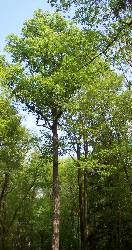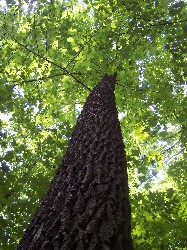| My
Backyard, Reynoldsville, PA |
Edward
Frank |
|
Mar
30, 2005 20:08 PST |
ENTS,

We own about 3/4 of an acre on a generally west facing hillside
in
Jefferson County, Pennsylvania, near the town of Reynoldsville.
The
coordinates of my house are 41 06.382N by 78 54.045W, elevation
1591. All
of the tree measurements are within a short distance of my
house,
considering the property size. My goal today was to obtain
enough
measurements to calculate a Rucker index for the property. The
property is
on the outskirts of a small town. The hill above my house is
flat topped
and wooded, with the forest rolling part way down each side. On
the west
side this forest changes to private lots with individual houses.
The east
side of the hill leads to abandoned fields and the local
Vo-Tech school.
Several of the trees on my property of reasonable size, and there
is a fair
amount of diversity, so I was off to measure a few trees.
The area is second growth forest that had been cut perhaps 80
years ago.
The canopy lies between 80 and 100 feet in height. The most
common canopy
trees are red maples, with a smaller number of oaks. The shrubs
in the
area include dense patches of mountain laurel and a few great
rhododendron,
transplanted from nearby areas. Patches of shrub sized black
cherry sprout
here and there. A few starts of sassafras still sprout, although
it has
been years since any tree sized sassafras grew in the area. In
the spring
the herbaceous layer includes mayapples, trillium, wintergreen,
and pink
lady slippers. I remember a few yellow lady slippers from my
boyhood, but
they are no longer present. Lady slippers are a native orchid.
Ferns are
plentiful and include among others: maidenhair, common bracken,
etc, as
well as several species of club moss.
The largest and most impressive of the trees is a 108.75 foot
high by 101"
cbh tuliptree in out lower yard.

Tulip Tree |

Black Gum |
Also along the lower yard are a
couple of
large white oak trees, These were doubles, but half of each died
a year
ago, and two years ago respectively. The remaining halves of the
doubles
are around 80" cbh and 90 feet high. I am sure there are
taller red maples
in the 80 foot range, but I was not able to measure any.
Species
height
(ft) cbh (ft)
Tuliptree
108.75 8.42
White Oak
106.94 6.08
Black Gum
70.63 3.46
White Oak
88.21 7.17
White Oak
xx
6.71
Hemlock
83.57 5.73
Red Maple
68.08 7.17
Yellow Birch
73.37 4.67
Chestnut Oak
83.05 5.92
American Chestnut 30.48 0.896
E. White Pine
93.51 6.19
Hemlock
78.28 4.29
American Beech 93.05 4.29
Cucumber Magnolia 86.80 5.83
Mountain Laurel 11.17 (7.75
inches at 1 foot)
Mountain Laurel 14.75 (7.87
inches at 1 foot)
Red Oak
88.38 7.42
Witch Hazel
~15 (5.25
inches breast height)
Yellow Birch
71.80 3.06
Rucker Index: 88.81
Last fall I purchased a Bushnell Yardage Pro Trophy rangefinder
to satisfy
my curiosity about the height of various trees I encounter. I
also wanted
to participate to a greater degree in the ENTS measuring
activities. To be
fair, I am not particularly happy with the instrument. I am
having trouble
getting a bounce from tree sprigs. I have used it a number of
times and am
convinced the problem is with the instrument more than my
technique. I am
sure I will improve with practice, butat the present time I
would not
recommend this particular model of rangefinder.
|
| Re:
My Backyard, Reynoldsville, PA |
wad-@comcast.net |
|
Mar
31, 2005 03:10 PST |
Ed
Sounds like a nice little patch you have there. Is the
wintergreen the spotted variety, or gaultheria procumbens? I
wish we had some of the lady slippers around here. What larger
town is Reynoldsville near? Nice variety of trees. We don't have
yellow birch or cuke magnolia here growing native. I have found
it difficult at times to get my rangefinder to lock on a small
bare twig too. I found shooting a larger limb, and then scanning
up to the tip seems to work better.
Scott
|
| RE:
My Backyard, Reynoldsville, PA |
Darian
Copiz |
|
Mar
31, 2005 06:19 PST |
Ed, ENTS
Sounds like a nice property, you even have American Chestnut -
nice.
Have you considered participating in the American Chestnut
Cooperators
Foundation? Related to this, what are people's thoughts on the
American
Chestnut Cooperator's Foundation vs. the American Chestnut
Foundation -
basically 100% native vs. about 94% native?
Darian
|
| RE:
Chestnuts |
wad-@comcast.net |
|
Mar
31, 2005 07:34 PST |
Darian
I am a proponent of native chestnut over the hybrids. Maybe I am
clueless about the possibility of C. dentata ever making a
rebound. I found a 10" last month and three 24+ trees last
fall. The 10 had signs of blight, but the bigger ones did not. I
plan to revisit them in spring to get samples for positive ID.
Do you have any contact info for the group you mentioned? I am
just getting into this, and haven't heard of them. We have a
small chestnut trial here on the grounds consisting of about 15
trees that are three years old.
Scott
|
| RE:
Chestnuts |
Darian
Copiz |
|
Mar
31, 2005 07:48 PST |
Scott,
I am also favor the 100% C. dentata. Here's the website for the
American Chestnut Cooperator's Foundation:
http://ipm.ppws.vt.edu/griffin/accf.html
The American Chestnut Foundation appears to have more
funding and a longer history,
but I am
uneasy about hybridizing the two species - to me it isn't really
an
American Chestnut even if it is 94% dentata. I think it is
possible for
the species to eventually build resistance, even if it takes a
few
hundred years, although I hope it is less than this. I remember
a
decent sized one at Longwood Gardens in a wooded area off of one
of the
asphalt paths (they may be treating it). I have also seen
several in
the Virginia mountains that had gotten big enough to set fruit.
From
what I have read there has been experimentation with a strain of
the
blight that is infected by a virus. This strain is being
introduced to
try and weaken the blight. I hope one day this tree will regain
at
least a portion of it's previous supremacy.
Darian
|
| RE:
My Backyard, Reynoldsville, PA |
Edward
Frank |
|
Mar
31, 2005 11:15 PST |
Scott,
I need to dig out my books to properly identify the various
flowers and
non-flowering plants - I will later this spring. I managed to
shoot a
85.69 height, 69" cbh red maple on the edge of the yard
today. That
pushes the RI for the property to 90.31. (I will admit, I think
the
cucumber magnolia is about 20 feet off the property line- so I
fudged a
little).
I counted the rings on the cut-down half of one of the twin
white oaks
at the lower edge of the yard at 100 annual rings. That seems a
fair
approximation for the property. I know there were some larger
white
pines and oaks on the hilltop, but they were logged about five
years ago
- made a mess of a once beautiful tract. There are still some
good sized
red oaks and chestnut oaks on the small tract adjacent to my
property.
I'll get some numbers for them soon.
Ed Frank
|
==============================================================================
TOPIC: Ed'd Woods
http://groups.google.com/group/entstrees/browse_thread/thread/a677e4f48611a6de?hl=en
==============================================================================
== 1 of 2 ==
Date: Mon, Jun 9 2008 9:31 am
From: "Edward Frank"
ENTS,
I made a brief walk in my woods this morning to check out mountain
laurel blooming behind my house. It is just beginning to bloom here. The
planted Rhododendron around peoples homes are almost done, but the wild
Rhododendron is just starting to show. When I got my first laser
rangefinder I did a quick Rucker Index of the acre or so around my home.
One of the trees on the list was an American Chestnut - it was only 30.5
feet high but represented the tenth species on the list. Unfortunately
it did nit survive the winter. I don't see signs of blight- it is just
dead. I did find a black cherry which I missed on the initial run
through of the Rucker, so overall the Index will increase. I need to go
out again soon and get some numbers.
Ed
== 2 of 2 ==
Date: Mon, Jun 9 2008 7:57 pm
From: James Parton
Ed,
Actually 30.5 feet ain't bad for an American Chestnut these days. It's
sad that it died though. I have found dead chestnuts with no signs of
the blight, at least at first glance. Sometimes it can be found right
at the base of the trunk. Right at ground level. I found a couple in
Cataloochee like that. Elsewhere on the trunk they were no signs of
the blight.
It's nice to have woods right at home. I have found no chestnuts here
in my home woods but Chinkapins are common.
James P.
==============================================================================
TOPIC: Ed'd Woods
http://groups.google.com/group/entstrees/browse_thread/thread/a677e4f48611a6de?hl=en
==============================================================================
== 1 of 1 ==
Date: Tues, Jun 17 2008 7:34 am
From: Elisa Campbell
Ed,
I just got back from a college reunion in Carlise, PA, and enjoyed
seeing the mt laurel in bloom along the roads - I-81 near and south of
Hazelton on the way to the reunion, and Delaware State Forest on the way
back. Here in Massachusetts the laurel outside my condo is in full bloom
now; I haven't had a chance to go out in the woods to see it there.
Traditionally, mid-June has been peak time for mt laurel in the
Connecticut River valley and nearby hills. It used to be particularly
spectacular in Wendell State Forest - due to the demise of many white
oaks after the gypsy moth infestations of the early 80s. Since the trees
have been doing better, the amount of bloom on the laurel has declined.
I expect the tornado damage two years ago will give a new burst of
sunlight and bloom in some areas of Wendell for a decade or so.
Elisa
|


